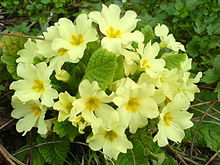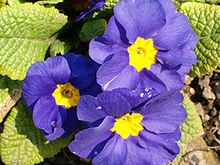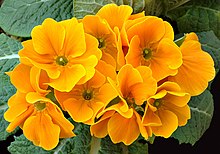Primula
| Primula | |
|---|---|

| |
| Primula vulgaris | |
| Scientific classification | |
| Kingdom: | |
| (unranked): | |
| (unranked): | |
| (unranked): | |
| Order: | |
| Family: | |
| Genus: | Primula |
| Species | |
|
many; see text | |






Primula (Template:Pron-en)[1] is a genus of 400–500 species of low-growing herbs in the family Primulaceae. They include primrose, auricula, cowslip and oxlip. Many species are grown for their ornamental flowers. They are native to the temperate Northern Hemisphere, south into tropical mountains in Ethiopia, Indonesia and New Guinea, and in temperate southern South America.
Perennial primulas bloom mostly during the spring; their flowers can be purple, yellow, red, pink, or white. Generally, they prefer filtered sunlight. Many species are adapted to alpine climates.
The word primula is the Latin feminine diminutive of primus, meaning first (prime), applied to flowers that are among the first to open in spring.
Primroses are used as food plants by the larvae (caterpillars) of some Lepidoptera species, including Duke of Burgundy butterfly, Large Yellow Underwing, Lesser Broad-bordered Yellow Underwing, Setaceous Hebrew Character and Silver-ground Carpet.
Some flowering forms of (cultivated) Primula are commonly known as polyanthus (P. elatior hybrids) as opposite to primrose (P.vulgaris hybrids).
Classification
The genus Dodecatheon originated from within Primula, so some authorities include the 14 species of Dodecatheon in Primula.[2]
Selected species
References
- ^ Sunset Western Garden Book, 1995:606–607
- ^ Alan S. Weakley (April 2008). "Flora of the Carolinas, Virginia, and Georgia, and Surrounding Areas".
